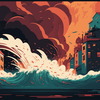Increase In Flooding Land And Property Due To Climate Change: Types, Causes, Effects, And Solutions
The earth's climate is changing, causing an increase in the frequency and severity of extreme weather events such as flooding. Floods can be particularly devastating for land and property owners, as they can cause significant damage and lead to long-term economic losses. Therefore, it's important to understand the causes and effects of flooding and to develop appropriate mitigation and adaptation strategies to minimize their impact.
Table Of Content
- Introduction
- Types Of Floods
- Effects Of Flooding On Land And Property
- Mitigation Measures To Reduce The Impact Of Flooding
- Adaptation Strategies To Cope With Flooding
- Conclusion
- Cause
- Is Caused By
Introduction
The impact of climate change is being felt across the globe, with rising sea levels and extreme weather events becoming more frequent and severe. One of the most significant consequences of these changes is an increase in flooding, which can have devastating effects on land and property. In this article, we'll explore the causes and effects of flooding due to climate change, and provide guidance on how to minimize its impact.
Types Of Floods
Floods are one of the most devastating natural disasters, and they can occur in various forms. Understanding the different types of floods is crucial for preparedness and mitigation efforts. Here are the five main types of floods:
- Riverine flooding - This type of flood occurs when river water levels rise above the normal level and overflow their banks. It is often caused by prolonged and heavy rainfall, snowmelt, or a combination of both. Riverine flooding can cause extensive damage to homes, businesses, and infrastructure, and it can last for several days or weeks.
- Groundwater flooding - Groundwater flooding happens when the water table rises and saturates the soil. It is often caused by heavy and prolonged rainfall, and it can occur in areas with shallow groundwater or poor drainage. Groundwater flooding can cause damage to buildings and infrastructure, and it can be challenging to detect and mitigate.
- Coastal flooding (storm surge) - Coastal flooding occurs when strong winds and low atmospheric pressure cause seawater to surge onto the land. It is often caused by hurricanes, tropical storms, or other weather events. Coastal flooding can cause severe damage to buildings, infrastructure, and coastal habitats, and it can also pose a threat to human lives.
- Urban flooding - Urban flooding occurs when rainwater is unable to drain due to impermeable surfaces like concrete and asphalt. It is often caused by heavy rainfall, inadequate drainage systems, or the buildup of debris in drainage channels. Urban flooding can cause damage to homes, businesses, and infrastructure, and it can also pose a threat to human lives.
- Flash floods - Flash floods happen when heavy rainfall or sudden snowmelt causes rapid and intense flooding. They are characterized by a fast-moving wall of water that can sweep away everything in its path. Flash floods can occur in any location, but they are particularly dangerous in urban areas with poor drainage systems.
- Dam failure floods - These occur when a dam or levee fails, leading to a sudden release of water that can flood downstream areas. Dam failure floods can be caused by a variety of factors, including poor maintenance, natural disasters, or human error. The force and volume of the water released during a dam failure flood can be extremely dangerous and damaging to people, property, and the environment.
- Ice jam floods - These floods occur when ice on a river breaks up and causes a blockage, leading to water overflowing the river banks. Ice jam floods are particularly common in cold regions during the spring thaw.
- Tidal floods - Tidal floods, also known as high tide flooding or nuisance flooding, occur when high tides cause water to overflow onto low-lying coastal areas. While not as severe as storm surge flooding, tidal flooding can cause damage to infrastructure and property.
- Landslide floods - These floods occur when a landslide blocks a river or stream, causing water to build up behind it and eventually overflow the banks. Landslide floods can be particularly dangerous as they can occur suddenly and with little warning.
- Coastal erosion floods - Coastal erosion floods occur when waves erode the shorelines and cause the land to subside. This can lead to low-lying areas becoming flooded during high tide or storms, even without a storm surge. Coastal erosion floods can cause damage to property, infrastructure, and coastal habitats, and they are a significant concern in areas with rapidly eroding shorelines.
- Sewer backup floods - These floods occur when sewer lines become blocked or overloaded, causing sewage to back up and flood homes or businesses. Sewer backup floods are often caused by heavy rainfall or other weather events, and they can pose a health hazard due to the risk of contamination.
- Glacier lake outburst floods (GLOFs) - These occur when a glacial lake rapidly drains, often due to a natural event like a landslide or avalanche, causing a large amount of water to flood downstream areas. GLOFs are typically found in mountainous regions and can be extremely dangerous due to the speed and force of the water.
- Floods caused by human activities - Certain human activities, such as damming rivers or modifying natural waterways, can increase the risk of floods. For example, building on floodplains or altering river channels can disrupt the natural flow of water and increase the likelihood of flooding.
- Ground ice floods - These occur when water from melting ground ice, such as permafrost, becomes trapped in an impermeable layer of soil or rock, causing it to flood the surface. Ground ice floods can occur in cold regions and can be particularly damaging to infrastructure and property.
- Rapid snowmelt floods - These occur when the snow melts rapidly due to warm temperatures or rain, causing rivers and streams to swell and overflow. Rapid snowmelt floods can occur in areas with significant snow accumulation, and they can be particularly dangerous if they occur suddenly and without warning.
It's important to note that each type of flood has unique characteristics and can pose different risks to people and property. Understanding the specific risks associated with each type of flood and taking appropriate mitigation measures can help individuals and communities to be better prepared and reduce the impact of floods.
Overall, while climate change may not directly cause all types of floods, it can increase their frequency, severity, and duration, making them more damaging to people, property, and the environment.
Effects Of Flooding On Land And Property
Flooding can cause significant damage to land and property, such as property damage, soil erosion, and health risks. Floodwaters can cause damage to homes and buildings, resulting in costly repairs or total loss. Soil erosion can lead to land degradation and reduced crop yields. Floodwaters can also contain harmful bacteria and pathogens, increasing the risk of health problems for humans and animals.
Mitigation Measures To Reduce The Impact Of Flooding
Mitigation measures can help reduce the impact of flooding. Building codes can require structures to be built to withstand flooding, reducing property damage. Flood insurance can provide financial protection in case of flood damage. Green infrastructure solutions, such as permeable pavement and rain gardens, can help reduce runoff and mitigate flooding.
Adaptation Strategies To Cope With Flooding
Adaptation strategies can help land and property owners cope with flooding. Elevating homes and buildings can reduce the risk of flooding and minimize property damage. Flood warning systems can provide advance notice of potential flooding, allowing property owners to take necessary precautions. Natural flood management strategies, such as wetland restoration and riverbank stabilization, can help mitigate the impact of flooding on land and property.
Conclusion
Flooding due to climate change is a serious concern for land and property owners. By understanding the causes and effects of flooding and taking appropriate measures to prepare for and cope with floods, we can reduce the damage and losses caused by these extreme weather events. Mitigation and adaptation strategies can help minimize the impact of flooding, providing greater protection and resilience to land and property owners.











